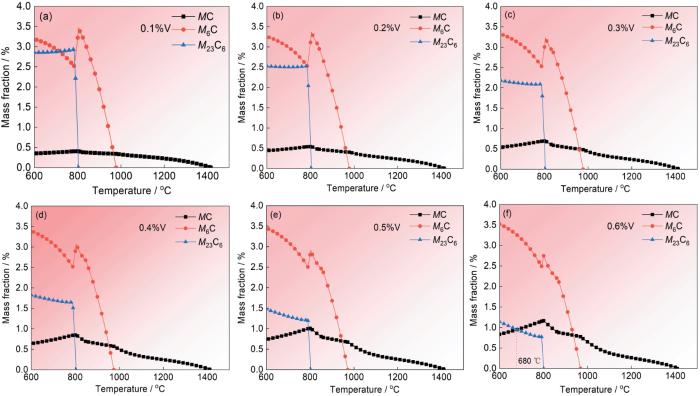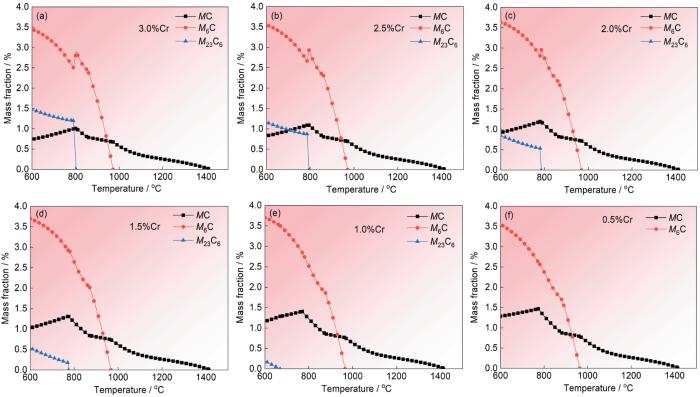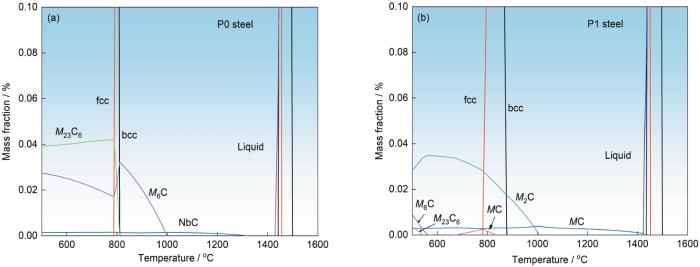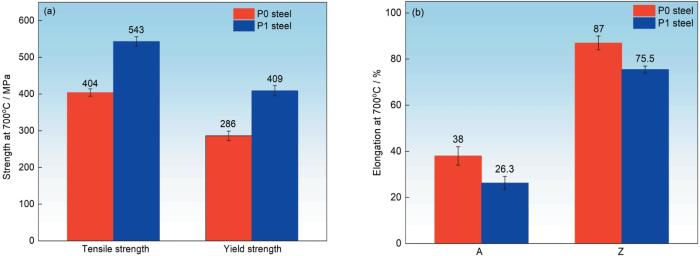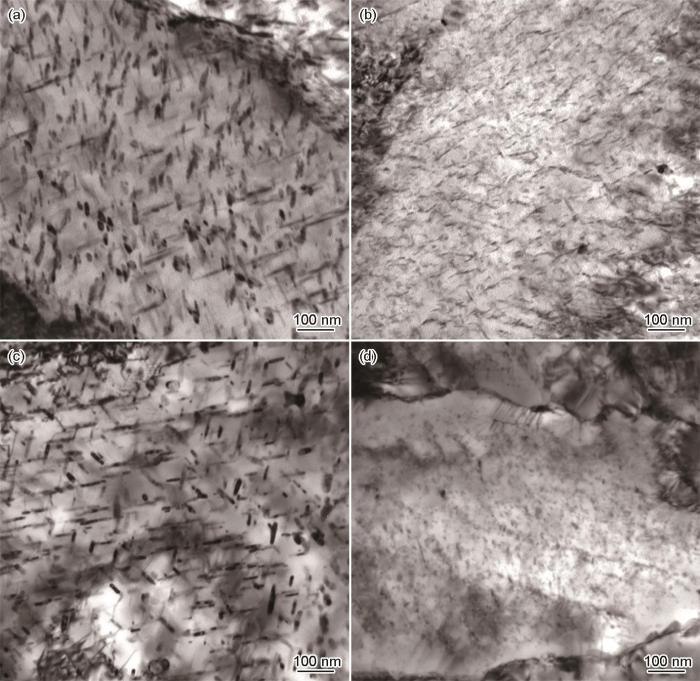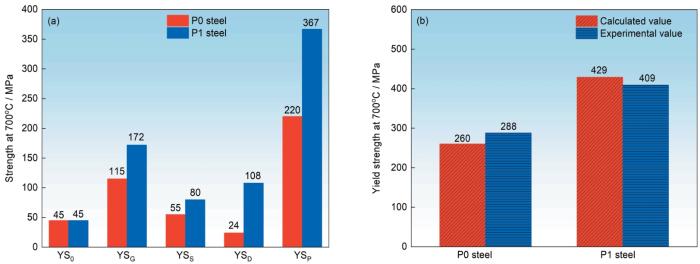对合金结构钢进行调质处理,不同类型的析出相可强化基体[5,6]。但是,在高温下析出相的成分、类型和尺寸等对其强化效果有较大的影响。Cr通常不利于高温强度,例如富Cr的M23C6在高温下的粗化影响材料的热稳定性[7,8]。Mo能细化M2C相起二次硬化作用使材料的强度提高,含Mo析出相良好的高温稳定性可改善其高温性能[1,9,10]。文献[11]的结果表明,V含量从0提高到0.4%可使钢的700℃高温强度由282 MPa提高到403 MPa。同时,添加V还能抑制M2C粗化和促进MC析出[12~15]。还有研究表明,Ti也能提高钢的高温强度。添加0.13%Ti的钢在580℃高温拉伸,其高温强度由930 MPa提高到1329 MPa。基于上述原因,本文对25Cr3Mo3NiNbZr钢进行成分优化,用高温拉伸、微观分析和表征析出相等手段研究其高温力学性能及其强化机理。
1 实验方法
实验用钢的成分列于表1。采用真空冶炼并浇注出25 kg钢锭,然后将其锻造成直径为20 mm长度为1000 mm的圆棒。在棒料上沿纵向切取拉伸试样(L0 = 5d0,d0 = 5 mm,L0为试样标距,d0为试样直径)、金相试样(直径为15 mm厚度为5 mm)和相分析试样(直径为10 mm长度为80 mm)
表1 实验用钢的化学成分
Table 1
| Steel | C | Cr | Mo | Ni | Nb | Ti | V | Zr | Fe |
|---|---|---|---|---|---|---|---|---|---|
| P0 | 0.28 | 3.0 | 3.0 | 0.8 | 0.13 | - | - | 0.02 | Bal. |
| P1 | 0.28 | 1.0 | 3.0 | 0.8 | 0.13 | 0.08 | 0.5 | 0.02 | Bal. |
热处理制度:在1050℃保温0.5 h后油冷,随后在640℃回火保温2 h后空冷。按图1所示将其精加工并根据GB/T 228.2-2015《金属材料拉伸试验第2部分:高温试验方法》用GNT100电子拉伸实验机进行700℃高温拉伸。从金相试样和接近高温拉伸断口切取透射片并减薄至0.5 μm,用电解双喷法进行离子减薄,电解液为4%高氯酸酒精溶液,恒定电流65 mA,用液氮使电解液温度恒定在-25℃左右,用FEI Talos F200X高分辨透射电镜观察高温拉伸前后的析出相特征和元素分布。因高温拉伸试样不足以支撑进行相分析,因此将其调质后在700℃热处理炉中保温15 min后空冷,以模拟高温拉伸后的状态,利用相分析对高温拉伸前后的碳化物进行定量分析。将用于测试位错密度的试样抛光后电解腐蚀(腐蚀液为铬酸,电压6 V,腐蚀25 s),用D8 ADVANCE型X射线衍射仪测试其衍射谱,用Co靶和Lynxeye XE探测器检测(管电流40 mA,管电压35 kV,扫描速度2 (°)/min。用体积分数为6%高氯酸酒精溶液对试样进行电解抛光,用JSM-7200F型扫描电镜和EDAX Velocity Super型电子背散射衍射附件测定分析试验钢的有效晶粒尺寸和晶界。
图1
2 实验结果
2.1 析出相的模拟
2.1.1 合金元素对平衡态析出相的影响
合金结构钢中碳化物的类型和稳定性,对其高温性能有决定性作用。钢中碳化物稳定性由大到小的排序为:MC相、M2C相、M6C相、M23C6相。因此,本文使用JMatpro软件模拟分析了钢中Cr、Mo元素以及强碳化物元素Ti、V的含量对平衡相图中析出相的影响。
从图2可见,随着Ti含量的提高M23C6的析出量逐渐减少,M6C相的变化不大,而MC相增加。
图2
图2
Ti对平衡态析出相的影响
Fig.2
Effect of Ti on the equilibrium precipitation phase (a) 0%Ti, (b) 0.05%Ti, (c)0.1%Ti, (d) 0.15%Ti, (e) 0.2%Ti (f) 0.25%Ti
图3给出了Mo含量不同的钢中平衡态析出相的变化趋势。可以看出,随着Mo含量的提高M23C6的析出量逐渐减少,M6C的析出量逐渐增多,MC相的变化不大。随着Mo含量从1.0%提高到3.5%,M23C6的析出量从4.8%降至2.8%。同时,Mo含量为3.5%时M6C相的析出量超过M23C6相,有利于提高钢的高温性能。因此综合考虑,Mo的含量应该为3.0%~3.5%。
图3
图3
Mo对平衡态析出相的影响
Fig.3
Effect of Mo on the equilibrium precipitation phase (a) 1.0%Mo, (b) 1.5%Mo, (c)2.0%Mo, (d) 2.5%Mo, (e) 3.0%Mo, (f) 3.5%Mo
图4
图4
V对平衡态析出相的影响
Fig.4
Effect of V on the equilibrium precipitation phase (a) 0.1% V, (b) 0.2% V, (c) 0.3% V, (d) 0.4%V, (e) 0.5%V, (f) 0.6%V
图5
图5
Cr对平衡态析出相的影响
Fig.5
Effect of Cr on the equilibrium precipitation phase (a) 3.0%Cr, (b) 2.5%Cr, (c) 2.0%Cr, (d) 1.5%Cr, (e) 1.0%Cr, (f) 0.5%Cr
2.1.2 平衡相图的对比
基于合金元素对析出相的影响,可适当提高Ti和V的含量以利于抑制M23C6的析出和促进MC相的析出,而适当降低Cr的含量能促进MC相的析出和抑制M23C6相的长大。据此设计了Fe-0.28C-1.0Cr-3.0Mo-0.8Ni-0.1Ti-0.5V-0.13Nb-0.02Zr,并使用Thermo-Calc软件计算了图6给出的两种钢的平衡相图。可以看出,P0钢的平衡状态以M23C6相和M6C相为主,有少量的MC相。改进成分后,P1钢以热稳定性较高的M2C相为主,M6C相和M23C6相大幅减少,且其固溶温度也分别由1000℃和800℃降低到600℃以下,后续热处理时可调整回火温度使其固溶在基体中。同时,模拟计算结果表明,P1钢中还有两种析出温度不同的MC相。
图6
图6
P0、P1钢的平衡相图
Fig.6
P0 and P1 steel balance phase diagram (a) P0 steel, (b) P1 steel
2.2 700℃下的高温力学性能
图7给出了25Cr3Mo3NiNbZr (P0)钢和实验用钢(P1)在700℃下的高温性能。可以看出,700℃时P0钢的抗拉强度为404 MPa,屈服强度为286 MPa,P1钢的抗拉强度为543 MPa,比P0钢提高139 MPa,屈服强度为409 MPa,比P0钢提高123 MPa,塑性比P0钢有所下降,塑性延伸率由38%降至26.3%,面缩率由87%降至75.5%。
图7
图7
P0、P1钢的700℃高温性能
Fig.7
700oC high temperature performance of P0 and P1 steel (a) strength, (b) elongation
2.3 析出相的变化
图8a、b给出了实验用钢在1050℃淬火0.5 h、在640℃回火2 h后析出相的形貌。可以看出,P0钢和P1钢的析出相均为长棒状,表明成分优化使析出相更加细小。图8c、d给出了在700℃高温拉伸析出相的形貌。可以看出,与拉伸前相比析出相有所增大,析出相多呈纺锤状。统计了透射图片中两种实验钢析出相的长度和横截面直径,结果在图9中给出。可以看出,P0钢拉伸前碳化物的平均长度为42.28 nm,大多集中在20~30 nm和30~40 nm,碳化物的横截面平均直径为9.73 nm,大多分布在6~10 nm;在700℃拉伸后,其碳化物平均长度为33.96 nm。根据统计结果,其大多分布在10~30 nm,比拉伸前的尺寸减小,而碳化物的横截面平均直径为12.98 nm,大多分布在10~14 nm。P1钢拉伸前碳化物的平均长度为13.53 nm,大多布在5~15 nm。高温拉伸后长度略有减小,平均长度为10.11 nm,集中分布在5~10 nm。P1钢中的碳化物其横截面直径拉伸前平均值为4.96 nm,高温拉伸后有所粗化,平均直径增大到5.87 nm。
图8
图8
700℃高温拉伸前后析出相的形貌
Fig.8
Carbide size before and after deformation at 700oC (a, c) P0 steel before and after deformation at 700oC, (b, d) P1 steel before and after deformation at 700oC
图9
图9
P0钢和P1钢700℃拉伸前后析出相尺寸的变化
Fig.9
Carbides size before and after deformation at 700oC of P0 steel (a, b) and P1 steel (c, d)
2.4 700℃高温拉伸前后的相分析
根据透射照片统计析出相,只能直观地了解析出相尺寸的变化。还要进行相分析深入了解析出相中元素的含量,以便深入研究合金元素对析出相的影响。表2列出了用相分析测定的700℃拉伸前后M3C析出量的质量分数。拉伸前P1钢中M3C相的质量分数为0.44%,P0钢中的为0.89%,是P1钢中的2倍。高温拉伸后两种试验钢中的M3C相都部分回溶进基体,但是P0钢中M3C的含量仍然比较高。
表2 700℃拉伸前后试验钢中M3C相的析出量
| The mass fraction of the elements in the M3C / % | ||||||||
|---|---|---|---|---|---|---|---|---|
| Fe | Cr | Mo | Ni | V | C* | Σ | ||
| P0 steel | Before | 0.393 | 0.201 | 0.237 | 0.006 | - | 0.054 | 0.891 |
| After | 0.208 | 0.145 | 0.158 | 0.0046 | - | 0.033 | 0.549 | |
| P1 steel | Before | 0.207 | 0.046 | 0.141 | 0.0076 | 0.015 | 0.026 | 0.443 |
| After | 0.0784 | 0.019 | 0.0577 | 0.0045 | 0.0074 | 0.0104 | 0.177 | |
表3列出了MC + M2C相中合金元素的析出量。由于MC相和M2C相的化学性质接近而无法将其分离,本文只分析MC和M2C相合金元素的变化。高温拉伸后,两种实验钢中合金元素都有所增加。相分析结果表明,实验钢中主要有Cr、Mo元素。700℃高温和拉伸产生的应力可能促进部分富Mo相析出。对比两种钢中Mo元素的含量,可见P1钢中Mo的析出量比P0钢的少。
表3 700℃拉伸前后试验钢中MC相+ M2C相的析出量
Table 3
| The mass fraction of the elements in the MC + M2C / % | |||||||||
|---|---|---|---|---|---|---|---|---|---|
| Fe | Cr | Mo | Nb | Ti | V | Zr | Σ | ||
| P0 steel | Before | 0.098 | 0.458 | 1.941 | 0.109 | - | - | 0.02 | 2.606 |
| After | 0.112 | 0.517 | 2.07 | 0.109 | - | - | 0.02 | 2.805 | |
| P1 steel | Before | 0.065 | 0.103 | 1.782 | 0.13 | 0.08 | 0.416 | 0.018 | 2.594 |
| After | 0.052 | 0.125 | 1.919 | 0.128 | 0.08 | 0.401 | 0.018 | 2.723 | |
3 讨论
3.1 析出相的演变
合金结构钢中析出相的尺寸、类型、析出量和稳定性对其力学性能有重要的影响。由图9可见,成分优化的P1钢中析出相明显细化,平均长度和横截面直径都比P0钢的小。按照公式
进行等效替换后[19],P0钢和P1钢在700℃拉伸前后析出相的等效球状平均直径列于表4。
表4 700℃拉伸前后析出相的等效球状平均直径
Table 4
| Steel | Average size before 700oC/nm | Average size after 700oC/nm |
|---|---|---|
| P0 | 18.00 | 20.47 |
| P1 | 7.93 | 8.14 |
图10
图11
3.2 700℃高温强化机制
显微组织分析结果表明,P1钢的高温强度源于析出了大量细小的纳米级碳化物,并且高温拉伸后仍保持较高的热稳定性。因此,有必要深入研究其高温强化机制。
随着基体温度的提高实验钢的剪切模量G显著降低,剪切模量与温度之间的关系为[22]
由此可见,室温下的GRT为80.5 GPa,700℃时G700℃为52.3 GPa,折减率为65%。
在700℃,细晶强化增量可表示为[23]
式中GT为700℃时的剪切模量,取52.3 GPa;GRT为室温剪切模量,取80.5 GPa;kHP为Hall-Petch系数,取600 MPa·μm1/2 [24];dg为实验钢700℃时的有效晶粒尺寸。
图12
图12
P0钢和P1钢的EBSD和原奥晶界叠加图和原奥氏体的晶粒尺寸统计
Fig.12
EBSD map overlapped with outlined prior austemite grain boundaries (a) P0 steel, (b) P1 steel, and (c) the distributions of prior austenite grain size
在700℃固溶强化增量[22]
是在室温固溶强化公式的基础上考虑了切变模量的折损率。式中[Mo]为固溶于基体中的质量百分数。
结合相分析结果和使用Thermo-calc软件,求得700℃时P0、P1钢固溶强化增量分别为55 MPa和80 MPa。
式中N为统计照片中析出相个数,dae为析出相平均直径,S为透射照片面积。由此可计算出,700℃拉伸后P0钢和P1钢中的析出相体积分数分别为3.88%和2.95%。根据Ashby-Orowan公式[27]和700℃时G的折损率,700℃沉淀强化增量为
式中GRT为室温下剪切模量80.5 GPa,f为析出相体积分数,d为析出相直径。由此可求得700℃时P0和P1钢的析出强化增量分别为220 MPa和367 MPa。
在室温下的马氏体钢板条内有大量的位错,在高温马氏体板条发生一定程度的动态回复使位错部分湮灭。用XRD测得P0钢和P1钢700℃时的位错密度分别为1.9137 × 1013 m-2和4.0526 × 1014 m-2。代入[22]
可计算出位错强化增量分别为24 MPa和108 MPa。式
图13给出了实验钢的强化增量。从图13a可以看出,实验钢在700℃均以析出强化为主,P1钢的强化增量比P0钢提高147 MPa。使用均方叠加公式式中YS0为点阵阻力,室温时YS0取70 MPa[28],700℃时考虑到剪切模量的折损率,取45MPa;YSG为细晶强化增量,MPa;YSS为固溶强化增量,MPa;YSD为位错强化增量,MPa;YSP为析出强化增量,MPa。由此计算出的理论屈服强度YS在图13b中给出。可以看出,P0钢和P1钢位错强化YS的理论计算值分别为260、429 MPa,与实测值相当,析出强化贡献73%强化增量。因此,通过该强化机理能进一步证明细化析出相,提高析出相的热稳定性,有利于提高高温强度。
图13
图13
试验钢的高温强化增量
Fig.13
Strengthening contributions at 700oC for P0 and P1 steel (a) the calculated contribution by different factors to yield strength; (b) theoretical and experimental values
4 结论
(1) 成分优化的25CrMo3NiTiVNbZr钢其700℃高温抗拉强度达到543 MPa,高温屈服强度达到409 MPa,比25Cr3Mo3NiNbZr钢提高100 MPa以上。成分优化使25CrMo3NiTiVNbZr钢中的析出相细化至7.93 nm,高温拉伸后仍约为8.14 nm,使其具有良好的热稳定性。
(2) 25CrMo3NiTiVNbZr钢和25CrMo3NiTiVNbZr钢在700℃的固溶强化差别很小,其高温性能提高的主要原因是析出强化。钢中尺寸更小、热稳定性更高的纳米级碳化物,有利于提高其高温性能。
参考文献
Effect of heat treatment on microstructure and mechanical properties of Cr-Ni-Mo-Nb steel
[J].
Design for Novel Hot-Work Die Steel by Thermodynamic Calculation and Microstructural Examination
[J].
A study on the strengthen reason of certain big gun tube material
[D].
某炮钢材料的强化机理研究
[D].
Study on mechanical and wear resistance of 25Cr3Mo3NiNbZr steel
[D].
25Cr3Mo3NiNbZr钢的力学与磨损性能研究
[D].
Evolution of secondary phase in G18CrMo2-6 steel during high temperature tempering
[J].
G18CrMo2-6钢在高温回火过程中第二相的演变
[J].应用扫描电子显微镜、透射电子显微镜和能谱技术等手段研究了G18CrMo2-6钢正火组织中第二相在680℃下保温一系列时间段的转变。结果表明, 在正火后贝氏体中析出相主要为马氏体/奥氏体(M/A)组元和合金渗碳体(M<sub>3</sub>C); 在回火保温初期M/A分解为铁素体(α)与M<sub>3</sub>C组织, 随着保温时间延长M<sub>3</sub>C逐渐球化并溶解, M<sub>23</sub>C<sub>6</sub>在晶界析出并长大, 同时基体上有细小弥散的MC相析出。即回火保温过程中组织随时间的延长发生M/A→α+M<sub>3</sub>C, M<sub>3</sub>C→M<sub>23</sub>C6+MC的变化。
Microstructural evolution and mechanical property changes of a new nitrogen-alloyed Cr-Mo-V hot-working die steel during tempering
[J].
Effects of Nb and tempering time on carbide precipitation behavior and mechanical properties of Cr-Mo-V steel for brake discs
[J].
Carbides and mechanical properties in a Fe-Cr-Ni-Mo high-strength steel with different V contents
[J].
Study on the microstructure and mechanical properties of high strength martensitic steel of 1350 MPa grade
[D].
1350 MPa级高强度马氏体钢组织与力学性能的研究
[D].
Development and study of high-strength low-Mo fire-resistant steel
[J].
Effects of vanadium content on the carbides transformation and strengthening mechanism of MPS-700V hot-work die steel at room and elevated temperatures
[J].
Newly developed high-strength martensitic stainless steel for the snipe rifle barrel with high shooting accuracy
[J].
Effect of vanadium on microstructure and high temperature properties of fire-resistant steels
[J].
钒对耐火钢显微组织及高温性能的影响
[J].
Effect of V and Nb on precipitation behavior and mechanical properties of high Cr steel
[J].
Effects of vanadium on the microstructure and mechanical properties of a high strength low alloy martensite steel
[J].
Regulation of microstructure and properties and damage mechanism study for 4Cr5MoSiV1(Ti)
[D].
4Cr5MoSiV1(Ti)组织性能调控及损伤机理研究
[D].
Research progress on carbide precipitation and evolution for H13 and H13-modifies hot working die steels during different heat treatment schedules
[J].
H13及改进型热作模具钢热处理过程中碳化物析出演化行为研究进展
[J].
Microstructure and tempering softening mechanism of modified H13 steel with the addition of Tungsten, Molybdenum, and lowering of Chromium
[J].
Characterization of the microstructures and mechanical properties of 25CrMo48V martensitic steel tempered at different times
[J].
Carbide evolution and service life of simulated post weld heat treated 2.25 Cr-1Mo steel
[J].
Structure Ouahrani T bonding and stability of semi-carbides M2C and sub-carbides M4C (M = V, Cr, Nb, Mo, Ta, W): A first principles investigation
[J].
High strength-superplasticity combination of ultrafine-grained ferritic steel: The significant role of nanoscale carbides
[J].There is currently a gap in our understanding of mechanisms that contribute to high strength and high plasticity in high strength UFG ferritic steel with nano-size Fe3C carbides in situations that involve combination of various strain rates and high temperature. In this regard, we describe the mechanistic basis of obtaining high strength-high plasticity combination in an ultrafine-grained (UFG) (~500 ± 30 nm) ferritic steel with nano-size carbides, which sustained large plastic deformation, exceeding 100 % elongation at a temperature significantly below 0.5 of the absolute melting point (Tm). To address the missing gap in our knowledge, we conducted a series of experiments involving combination of strain rate and temperature effects in conjunction with electron microscopy and atom probe tomography (APT). Strain rate studies were carried out at strain rates in the range of 0.0017-0.17 s-1 and at different temperatures from 25 °C to 600 °C. Dynamic recrystallization occurred at 600 °C, resulting in a significant decrease in yield and tensile strength. Nevertheless, the UFG ferritic steels had an advantage in tensile strength (σUTS) and elongation-to-failure (εf) at 600 °C, especially at strain rate of 0.0017 s -1, with high σUTS of 510 MPa and excellent low temperature (< 0.42Tm) superplasticity (εf = 110 %). These mechanical properties are significantly superior compared to similar type of steels at identical temperature. A mechanistic understanding of mechanical behavior of UFG ferritic steels is presented by combining the effect of strain rate, temperature, and nano-size carbides.
Effect of grain boundary segregation of interstitial elements on Hall-Petch coefficient in steels
[J].
Measurement of size distribution and volume fraction of precipitates in silicon steel
[J].
硅钢中析出物的尺寸分布以及体积分数的测定
[J].
Nanoscale cementite precipitates and comprehensive strengthening mechanism of steel
[J].
Microstructure and high-temperature tensile behavior of modified H13 steel with the addition of tungsten, molybdenum, and lowering of chromium
[J].







